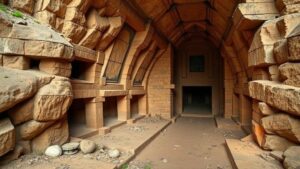Exploring the “Garden of Celestial Harmony,” where natural formations align with sacred geometry.
Exploring the “Garden of Celestial Harmony”
Located in the picturesque region of Yunnan Province, China, the “Garden of Celestial Harmony” is an extraordinary site where natural formations align with the principles of sacred geometry. This remarkable convergence creates a fascinating subject for both spiritual seekers and science enthusiasts alike. In this article, we will delve into the historical significance, natural wonders, and the geometric principles that make this location a unique fusion of natural beauty and cosmic design.
Historical Context
The “Garden of Celestial Harmony” is not just a product of nature; it has historical roots that date back to ancient Chinese philosophical and spiritual traditions. site, believed to have been established during the Tang Dynasty (618-907 AD), integrates various elements of Taoism and Buddhism, which emphasize harmony with nature and the universe. These traditions inform the cultural landscape, providing a deep sense of place.
One notable historical figure associated with the region is Zhuge Liang, a renowned strategist and chancellor of the Shu Han state during the Three Kingdoms period (220-280 AD). His teachings on balance and harmony resonate deeply with the management of this landscape, reflecting a long-standing appreciation for the alignment of nature and geometry.
Navigating the Natural Formations
The geographical features of the “Garden of Celestial Harmony” are a testament to the powerful forces that shaped them over millennia. site is adorned with towering cliffs, flowing rivers, and lush valleys, all of which epitomize the beauty of natural aesthetics. The natural elements serve as living examples of sacred geometry, with formations that appear to conform to the Fibonacci sequence and other geometric principles observed in both nature and human constructs.
- The Fibonacci Sequence: This mathematical pattern appears in various natural forms, from the spirals of shells to the branching of trees, and is mirrored in the layout of the “Garden.”
- Geometric Patterns: Many paths and watercourses within the garden reflect optimal flow and symmetry, reminiscent of sacred geometric shapes like the Golden Ratio that is pervasive in ancient architecture.
Spiritual Significance
The alignment of natural formations with sacred geometry in the “Garden of Celestial Harmony” serves profound spiritual purposes. Visitors often claim that the site promotes a deep sense of tranquility and connection to the cosmos. This is evidenced by the numerous temples and meditation spots found throughout the garden that encourage mindfulness and reflection.
For example, the Harmony Pavilion, located at the gardens center, features a circular platform designed to symbolize unity and completeness–a fundamental aspect of many spiritual doctrines. This spatial design allows for an immersive experience that reinforces the idea of oneness with nature.
Scientific Perspectives
From a scientific standpoint, the “Garden of Celestial Harmony” presents opportunities for geologists, biologists, and land-use planners to study the interplay between natural formation and geometry. The regions biodiversity is rich, featuring numerous endemic species. unique geological formations provide insights into the Earth’s evolutionary processes and the environmental conditions that influenced these shapes.
In fact, a study published in 2020 in the Journal of Natural History analyzed the impact of natural formations on local ecosystems and how these layouts can inspire sustainable designs in urban planning. The findings suggest that incorporating the principles observed in the “Garden” may lead to more resilient and harmonious urban environments.
Real-World Applications
The “Garden of Celestial Harmony” offers practical lessons applicable to various fields, including architecture, urban planning, and landscape design. By studying the site’s use of sacred geometry, architects and designers can design spaces that are not only functional but also promote well-being.
- Integrative Architecture: Incorporating natural elements mirroring sacred geometry can enhance the aesthetic and spiritual qualities of buildings.
- Sustainable Practices: The understanding of natural formations can influence sustainable practices in urban landscaping and planning, leading to eco-friendly developments.
Conclusion
Exploring the “Garden of Celestial Harmony” reveals the stunning intersection of nature, spirituality, and science. Its historical depths and unique natural formations challenge us to reflect on our relationship with the world around us. As such, this site stands as a poignant reminder of the beauty that arises from balance and harmony, inspiring future generations to appreciate and protect such extraordinary environments.
For those wishing to visit, planning a trip to Yunnan Province while keeping these principles in mind can provide both an educational and transformative experience. By engaging with the landscape consciously, one can uncover the secrets that nature and geometry have to offer.



